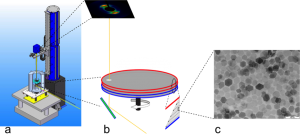Shearing nematic platelets
Most soft matter materials cannot be classified as fluids or solids because they possess a dual character: they can have a response that is solid-like or fluid-like, depending on the mechanical deformation. This dual, visco-elastic, character can also be found in an important class of soft matter systems, namely liquid crystals. Liquid crystals can be formed by small ‘colloidal’ platelets, such as clay particles, which all have similar orientation, so that they are in a nematic phase despite of their Brownian motion, which makes them colloidal. We subjected these dispersions of platelets to an oscillating shear field, squeezing the dispersions between two moving plates. By combining this geometry with x-ray scattering, we uncover the structural origin of the transformation between solid and liquid-like behaviour. These new insights might change the view on the origin of visco-elastic behaviour in complex fluids.

(a) Cartoon of the Rheo-SAXS set-up, with the deflected beam, vertical deteion line and the shear cell. (b) The geometry of the plate-plate shear cell showing the light-path of the x-ray beam. (c) Gibbsite platelets that were used in the experiment. Scale bar 500 nm.
